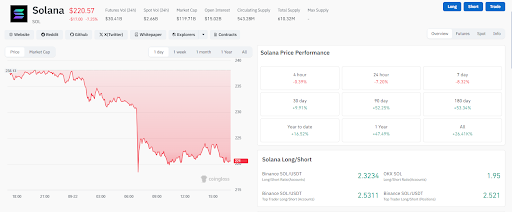Solana could outperform Bitcoin and Ethereum soon, especially as staking yields and corporate treasuries continue to push growth.
Solana continues to become more interesting as institutions jump in. While Bitcoin and Ethereum currently dominate the headlines, new adoption cycles indicate that Solana could close the gap soon.
Institutional portfolios hold far less Solana than Bitcoin or Ethereum. Less than 1% of Solana’s supply is held by professional players, compared to about 16% for BTC and 7% for ETH.
This leaves a great deal of room for growth.
1/ We believe Solana is approaching a major inflection point in its adoption—by consumers, fintechs, & institutions.
Blue-chip companies like Stripe & PayPal are starting to build on it.
The stories for Bitcoin and Ethereum have largely been told. Solana's is just beginning
— Pantera Capital (@PanteraCapital) September 18, 2025
Pantera Capital has noted that adoption should be measured by real-world use cases, not just financial instruments. Stripe and PayPal are also integrating Solana into their services, which shows that confidence in its ability to handle payments is on the rise.
Yet despite all of this, the absence of a Solana ETF continues to be a major gap.
Still, if regulators approve one, demand might rise very quickly and force institutions to reallocate into SOL.
Corporate treasuries are starting to see Solana as a practical reserve asset. This is because staking on Solana typically delivers returns of 7% to 8%, compared to 3% – 4% on Ethereum and none on Bitcoin.
For businesses, this difference translates into steady cash flow and stronger balance sheets.
Throughput is also one of the major things that set Solana apart. The network processes far more interactions at lower fees and with faster confirmation times. This makes it useful for firms that want to experiment with payments, loyalty systems or even digital utilities without high costs.
Volatility is often seen as a risk. However, it can also be an opportunity. Solana is far more volatile than BTC and ETH, which means that treasury vehicles will be able to accumulate tokens faster.
Nasdaq-listed DeFi Development Corp. and Fragmetric Labs have launched the first Solana digital asset treasury in South Korea. These companies are looking to acquire a local public company, rebrand it, and manage it with Solana-focused strategies.
We're extremely excited to announce that Fragmetric Labs and DeFi Development Corp. (NASDAQ:DFDV) will launch the first Solana Digital Asset Treasury in Korea through the acquisition of a Korean publicly-listed company. pic.twitter.com/rzGbVvmEXT
— Fragmetric (@fragmetric) September 22, 2025
DFDV already holds more than 2 million SOL, and is one of the largest public treasuries for the token. Its combination of staking yields with revenue from its real estate operations means that the company has created a dual-income model that is tied to Solana’s growth.
Fragmetric Labs also adds its expertise in liquid staking to the mix, and currently manages more than $96 million in assets according to DefiLlama.
At the time of writing, Solana trades near $220 after a recent sell-off across the crypto market. Despite short-term pressure, traders on Binance still appear to be bullish.
For example. CoinGlass data shows a long-to-short ratio above 2.5. This indicates that most expect prices to recover.

According to CoinGecko, Solana has gained 53% in the past year and 10% over the last month.
Analysts believe that a strong close above $250 could pave the way for a test of $300 before the end of the year. Some traders even project long-term targets as high as $500 if the general market conditions improve.
The post Could Solana Treasuries Beat Bitcoin And Ethereum Soon? appeared first on Live Bitcoin News.
Also read: Crypto Bloodbath Wipes Out $1.8 Billion as Overleveraged Traders Pay the Price